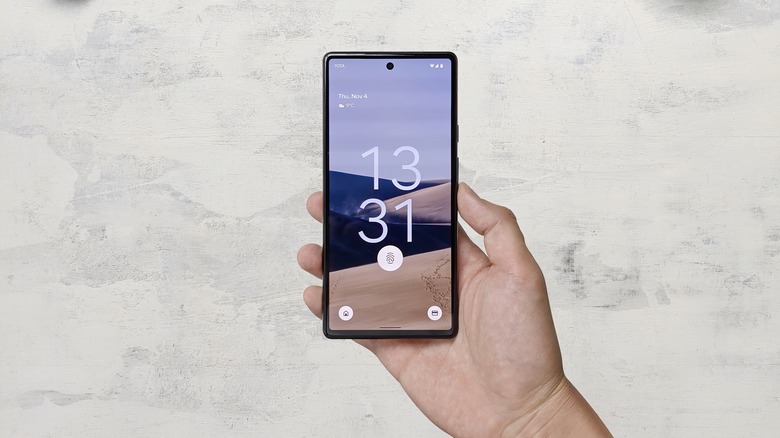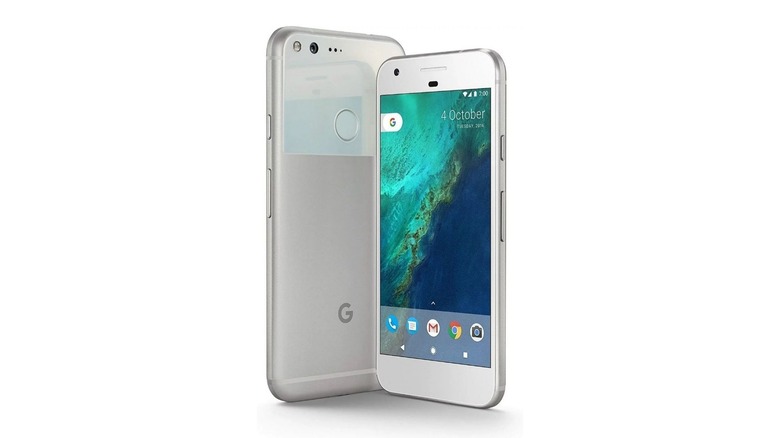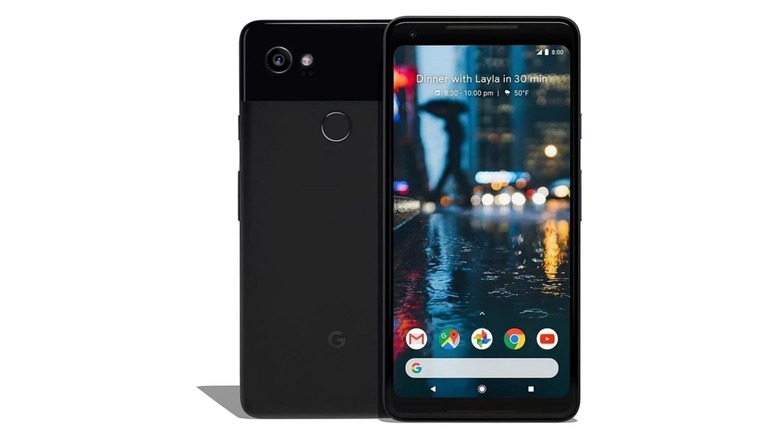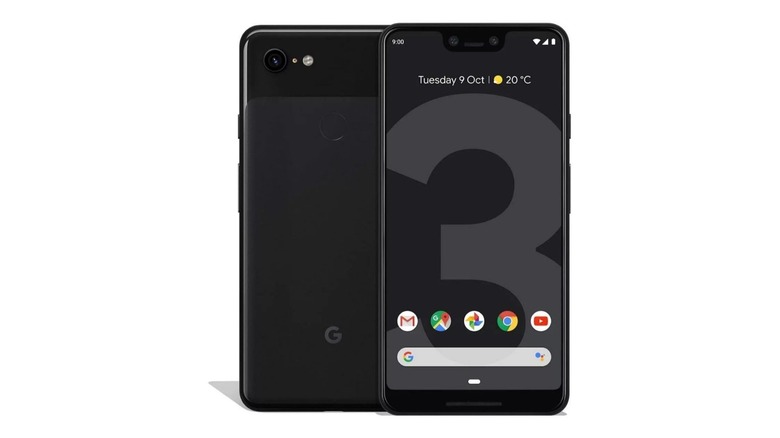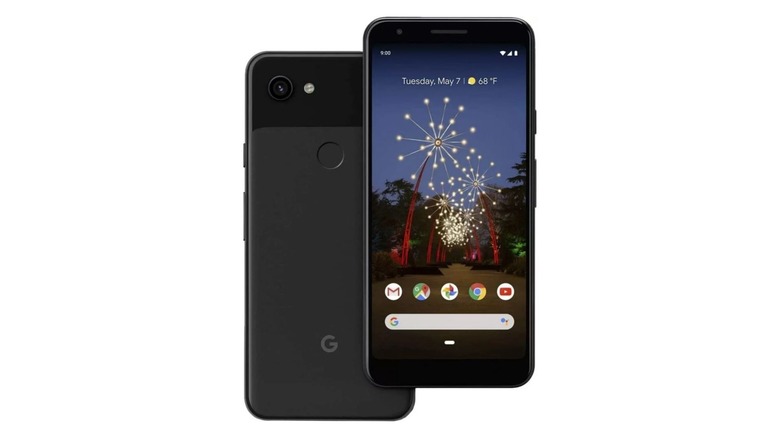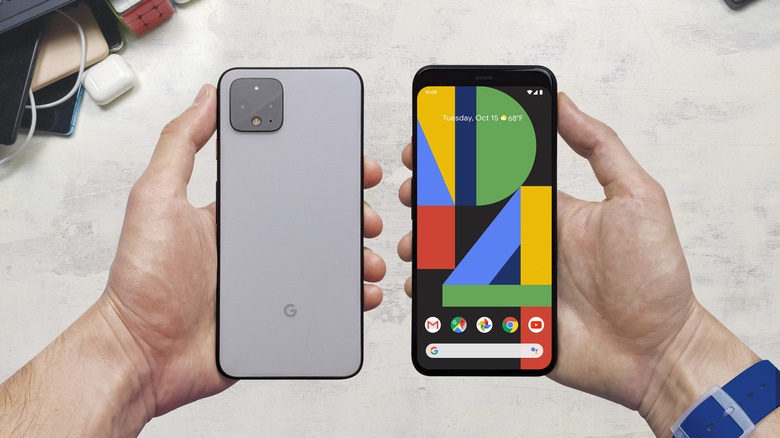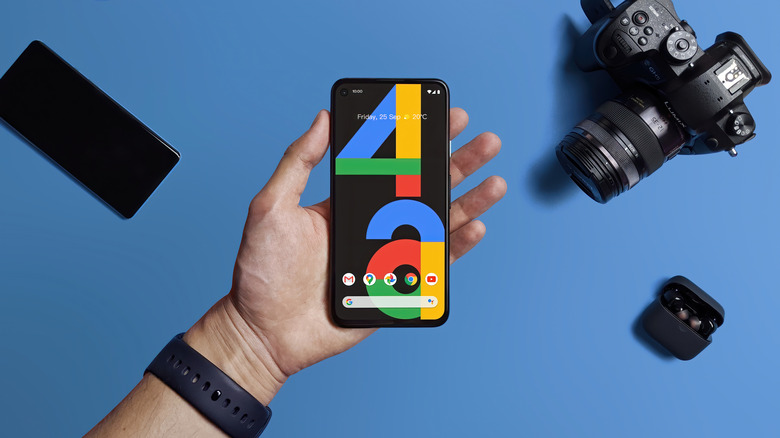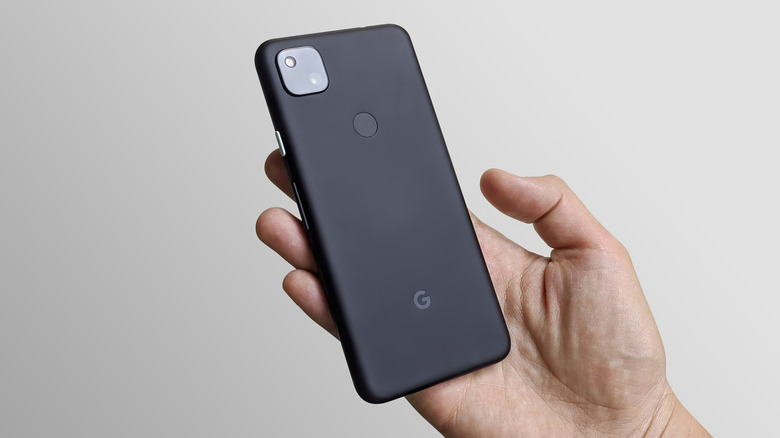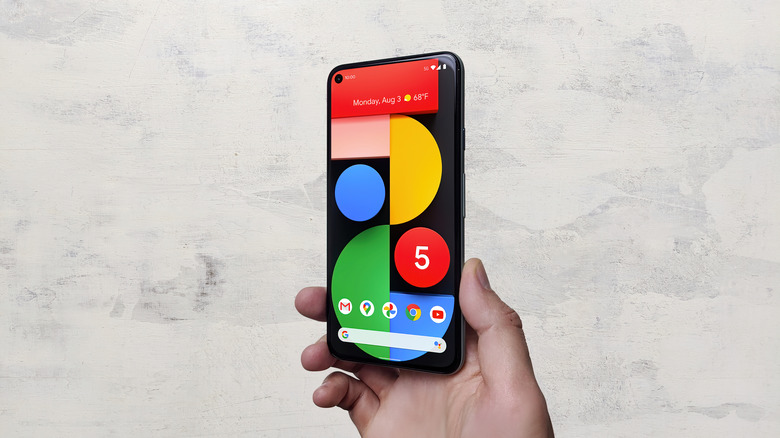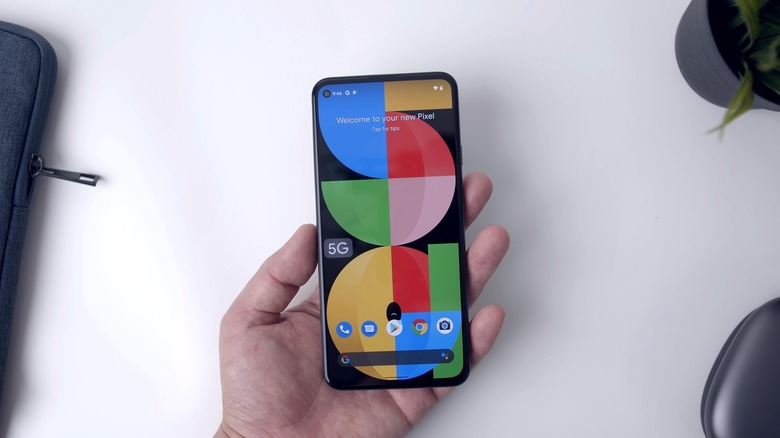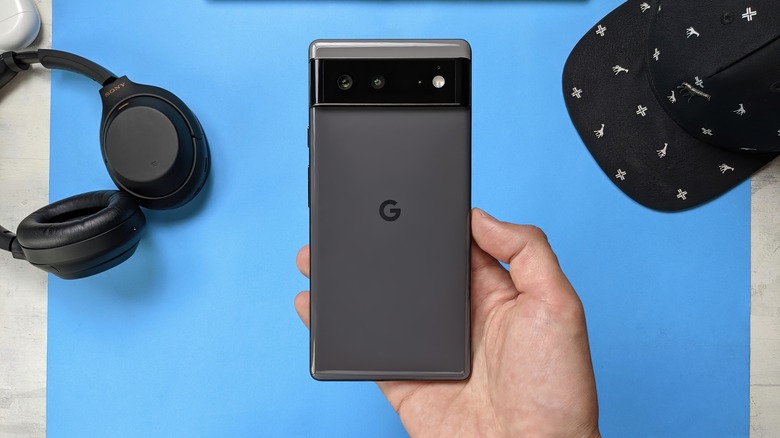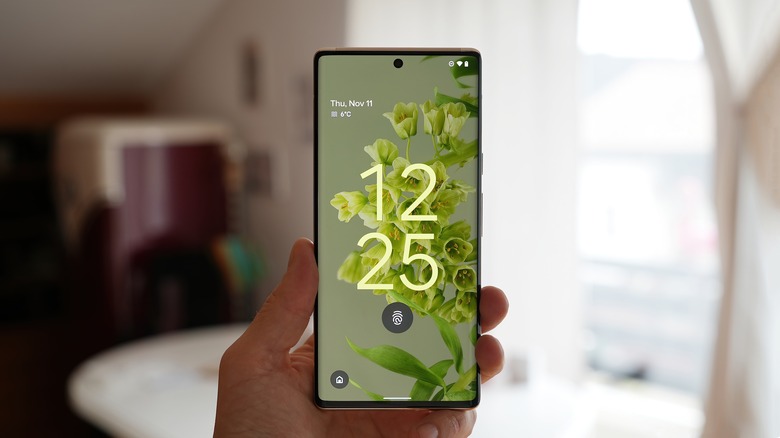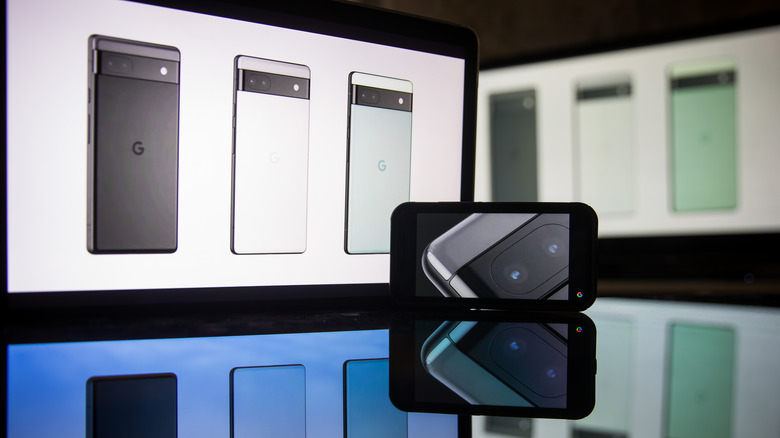Every Google Pixel Smartphone In Order Of Release
Google's Pixel series has become a staple in the world of flagship smartphones. Known for its excellent photo-taking capabilities, the Pixel phone series has always been relatively well regarded by consumers and smartphone reviewers, even from its original release in 2016. Starting in 2011, Marc Levoy and a team of creators at Google X (now simply called X, an Alphabet company), started working on applying computational photography to mobile devices; this technology, five years later, was a key feature in the value proposition of the first Pixel phone.
The release of Google's first Pixel phone in 2016 meant that the company had to deal with stiff competition from other, more established companies in the smartphone industry — many of which had been using the company's own Android operating system with great success. One major outlier, Apple, released its first iPhone in 2007, nine years before Google's first Pixel phone release. Of course, Google released other smartphones before its Pixel series, but none were quite as popular.
Between 2016 and now, Google released new Pixel devices every year like clockwork. Each new Pixel phone represents the best of what Google's Android has to offer. Each Pixel is aimed at giving consumers a choice outside of what's become the default for most new smartphone consumers over the past decade, namely Samsung's Galaxy lineup and Apple's iPhone.
Google Pixel and Pixel XL - 2016
The first two entries to Google's Pixel line were the Pixel and the Pixel XL. Both smartphones were released in October 2016, with the Pixel XL being the more premium of the two.
Google heavily emphasized the awesome cameras on both the Pixel and the Pixel XL. For a little over six months after release, the Pixel phone family had what was considered the best smartphone camera setup by DxOMark's smartphone camera rankings. When the HTC U11 was released in 2017, it ended up sharing the top spot with Google's first two Pixel phones. Taking photos on the original Pixel phones was highly encouraged with Google's "Unlimited" Original Quality photo storage feature tied to Google Photos. The unlimited part of the promise still appears to be honored today, with some caveats.
The Pixel had a 5-inch AMOLED display with 1080 x 1920 resolution, while the Pixel XL had a 5.5-inch AMOLED display with a 1440 x 2560 resolution. The Pixel XL also had a slightly larger battery capacity of 3450 mAh, while the Pixel's battery capacity was 2770 mAh. These are the only two significant specs that differentiate the Pixel from the Pixel XL.
Both phones were equipped with a Qualcomm Snapdragon 821 processor, options for 32GB or 128GB of storage, 4 GB LPDDR4 RAM, an aluminum design with an IP53 rating, and Android 7.1 Nougat at launch. Both phones supported an OS upgrade up to Android 10, and the two phones shared a 12.3 MP rear camera with a Sony Exmor sensor, as well as an 8 MP front camera.
Google Pixel 2 and 2 XL - 2017
Google only made a few small changes in between the first Pixel release in 2016 and the release of the Pixel 2 and Pixel 2 XL in 2017. Battery capacity didn't change too much from the first Pixel, with the Pixel 2's battery capacity at 2700 mAh and the Pixel 2 XL's battery capacity at 3520 mAh. Google also nixed the 32GB storage options present with the first Pixel devices and only presented consumers with an option of 64 GB or 128 GB for Pixel 2.
The Pixel 2 series had a newer Qualcomm Snapdragon 835 processor and 4 GB of LPDDR4X RAM, which was slightly faster than the original Pixel's LPDDR4 RAM. Both phones also got a major IP rating upgrade; with an IP67 rating, Google's Pixel 2 line was more dust-resistant and able to be submerged for up to a meter in water.
Google also released the Pixel 2 with a handy hardware feature it gleaned from its recently acquired HTC crew. As it was with the HTC U11, a new feature allowed users to squeeze the sides of their Pixel 2 to launch Google Assistant. This same squeeze function could be used to dismiss incoming calls, snooze alarms, and turn off timers. You could also easily flip your phone over so it was face down to automatically enable Do Not Disturb mode.
From the Pixel to the Pixel 2, the display didn't change at all; the Pixel 2 had a 5-inch AMOLED display with 1920 x 1080 resolution. From the Pixel XL to the Pixel 2 XL, however, the display upgraded in both size and resolution. The Pixel 2 XL boasted a 6-inch P-OLED display with a 1440 x 2880 resolution.
The front camera on the Pixel 2 was effectively identical to its predecessor at 8 MP, and the rear camera had a minor resolution drop from 12.3 MP to 12.2 MP. The difference was offset by an upgraded Sony Exmor IMX362 lens with a lower aperture, meaning it could capture more light and take better pictures. Google also kept the unlimited Original Quality photo storage feature, though it's no longer supported as of January 16, 2021.
Google Pixel 3 and 3 XL - 2018
Next in Google's line of Pixel phones were the Pixel 3 and the Pixel 3 XL. The 3's battery capacity was upgraded from 2700 mAh to 2915 mAh, while the 3 XL was downgraded slightly from 3520 mAh to 3430 mAh. Although the 4 GB of LPDDR4X RAM stayed the same, both phones saw an upgrade to the latest Snapdragon processor, the 845, as well as a slight boost in the IP rating from IP67 to IP68. Storage options for both phones were identical to the previous generation at 64GB and 128GB. The phones came with Android 9 (Pie) installed, though both were able to upgrade to Android 12.
One of the most significant improvements for both phones was in the display, though the Pixel 3 XL had what some considered a rather unfortunately sizeable notch. Since all the previous Pixel phones had a rectangular screen fit inside larger bezels rather than a full-size screen with a camera notch, the benefits of the notch did not necessarily outweigh the drawbacks. The Pixel 3 had a beautiful 5.5-inch OLED display with a 2160 x 1080 resolution, while the Pixel 3 XL had an even more stunning 6.3-inch OLED display with a 2960 x 1440 resolution.
The phones also received the newest Sony Exmor IMX363 sensor in its 12.2 MP rear camera array, and Google introduced a dual camera set up in front, one of which had a 97-degree field of view.
Both the Pixel 3 and 3 XL also had the same squeeze gesture hardware as the Pixel 2, also allowing users to call upon Google Assistant and dismiss active notifications. These were the last phones to ever have unlimited Original Quality photo storage from Google, though as of January 1, 2022, it's no longer supported.
Google Pixel 3a and 3a XL - 2019
The Pixel 3a and 3a XL were the first two entries in Google's budget line of phones, all designated as such by the addition of a single letter at the end of their predecessors' names. Luckily, these two phones didn't see much of a downgrade.
Display size and display resolution for both phones weren't much different than their predecessors, aside from having Asahi Dragontrail Glass instead of Corning Gorilla Glass 5 for protection against drops and scratches. The Pixel 3a boasted a slightly larger 5.6-inch OLED display with 2220 x 1080 resolution, and the 3a XL had a 6-inch OLED display with 2160 x 1080 resolution.
Each phone had 4 GB of LPDDR4X RAM, one storage option of 64 GB, a 12.2 MP rear camera, and an 8 MP front camera. This device was launched with Android 9 (Pie), upgradable to Android 12, and a Qualcomm Snapdragon 670 processor. It was in part the implementation of a lesser chipset (from 845 to 670) that enabled Google to drop the price for the 3a and 3a XL.
On the bright side, the battery capacity of the 3a and 3a XL was actually better than that of the 3 and 3 XL; the 3a had a 3000 mAh battery and the 3a XL had a 3700 mAh battery. At the same time, the release of the Pixel 3a and 3a XL marked the end of the era of unlimited storage at "original quality" with Google Photos on Google Pixel devices.
Google Pixel 4 and 4 XL - 2019
Compared to the Pixel 3 and 3 XL that came before these two phones, the Pixel 4 and 4 XL improved in all the ways consumers wanted. Both phones received the standard improvements in a next-gen phone at the time, like an upgrade to Qualcomm's newest Snapdragon 855 processor, an extra 2 GB of LPDDR4X for a total of 6GB, and a rollout of Android 10, with the ability to upgrade to Android 12.
Each phone's display and battery capacity didn't change too much. The Pixel 4 had a battery capacity of 2800 mAh, and the 4 XL's battery capacity was 3700 mAh. Then, the Pixel 4 had a 5.7-inch display, slightly larger than the Pixel 3, with a 2280 x 1080 resolution. The Pixel 4 XL had a 6.3-inch display with a stunning 3040 x 1440 resolution.
Google's Pixel 4 and 4 XL also had the squeeze features of the 2/2 XL and 3/3 XL, where you could squeeze the sides of the phone to trigger Google Assistant. Google also activated a few sensor-based gestures to the mix with this Pixel family. A simple wave of a user's hand over the phone's front side and they'd be able to silence calls, alarms, and timers. Users could also wave a hand to skip a song or go back to a song that just played while actively listening to music.
The biggest upgrade with these two phones was with the rear camera array. The front camera stayed at 8 MP but increased its field of view to 90 degrees. Then, in addition to the standard 12.2 MP rear camera, Google added an extra 16 MP telephoto sensor that gave Pixel users even more opportunities to take beautiful photos.
Google Pixel 4a - 2020
Google's first experiment with a budget line of Pixel phones did so well that the company also released a Pixel 4a smartphone after the initial launch of the Pixel 4 and 4 XL. To make it reasonably priced for consumers, Google dropped the Qualcomm Snapdragon 855 and subbed in the Snapdragon 730G. Though it's still a fairly powerful processor, especially when paired with 6 GB of LPDDR4X RAM and 128 GB of storage, it's not quite as top-tier as the Snapdragon 855.
Despite it being a budget phone, Google didn't skimp on battery capacity for the Pixel 4a. It has a 3140 mAh battery, which is larger than that of the Pixel 4's battery. Also, just like the 4 and 4 XL, the Pixel 4a launched with Android 10 and is able to upgrade to Android 12.
Another budget-saving decision was made with the camera setup. Whereas the Pixel 4 and 4 XL experimented with the first telephoto lens in the series, the Pixel 4a only had an 8 MP front camera and a 12.2 MP dual-pixel sensor on the back of the phone. What a lot of users loved to see with the Pixel 4a was a punch-hole camera design rather than a notch design, which offered a bit more screen space.
Google Pixel 4a (5G) - 2020
Although Google announced the Pixel 4a and Pixel 4a 5G around the same time in the fall of 2020, the phones were more different than previous phones released together, like an XL version paired with its numbered version. For example, the Pixel 3 and 3 XL were released with the same processor, but that wasn't the case for the Pixel 4a and 4a 5G. Instead, the Pixel 4a 5G received a slightly more powerful processor: the Qualcomm Snapdragon 765G.
The Pixel 4a 5G also received an upgrade to its display and battery capacity. It had a beautiful 6.2-inch OLED display with a 2340 x 1080 resolution that used Corning Gorilla Glass 3. Then, it had a 3885 mAh battery, which was the largest battery offered by a Google Pixel phone to date.
As the name implies, this smartphone supported 5G capabilities. With 5G, the phone was able to download files faster, experience smoother streaming of video content, and overall lower latency during tasks.
Google Pixel 5 - 2020
Apparently, Google loved the balance between price and performance of Qualcomm's Snapdragon 765G processor so much that it stuck around for the newest Pixel 5 smartphone. There was also 8 GB of LPDDR4X RAM, the most ever in a Pixel phone, and one storage option of 128 GB.
It launched with Android 11, though it can be upgraded to Android 12 if you purchase it today. The 6-inch OLED display is covered with Corning Gorilla Glass 6, a reinforced glass option that is stronger than any previous Pixel display, protecting its 2340 x 1080 resolution panel below for crystal clear viewing. Google also upgraded the battery capacity yet again to be 4080 mAh.
Whereas the Pixel 4 and 4 XL phones had a 16 MP telephoto sensor, the Pixel 5 was equipped with a 16 MP ultra-wide sensor. This is, of course, in addition to the main 12.2 MP rear camera. The front camera didn't bring anything new to the table; it stayed at 8 MP.
Google Pixel 5a - 2021
Many smartphone brands don't put a lot of thought into their budget phones, but Google does. Despite the Pixel 5a being marketed as a more affordable alternative to the Pixel 5, it packs quite a powerful punch.
At launch, the Pixel 5a was about $250 less expensive than the Pixel 5, but it had the same processor, the same amount of storage, same camera set up, 6 GB of LPDDR4X RAM instead of 8 GB, and ran Android 11 right out of the gate, with the ability to upgrade to Android 12 when it released. It even had a larger 4680mAh battery that could last all day (and then some) and fast charge.
The 5a's display was larger and just as crisp, but not quite as strong as the 5. The Pixel 5a had a 6.34-inch OLED display with a 2400 x 1080 resolution that used Corning Gorilla Glass 3 instead of Gorilla Glass 6 like the Pixel 5.
Many people felt that the Pixel 5a didn't offer much more than the Pixel 4a 5G, even though it was more expensive. Eventually, however, the Pixel 4a and even the 5 were phased out, leaving the 5a as the only option unless you wanted to splurge on the more expensive Pixel 6 or 6 Pro.
Google Pixel 6 - 2021
Things just kept getting better and better with Google's Pixel 6 phone. In almost every way, the Pixel 6 is superior to all previous Pixel phones. Instead of simply upgrading the processor or making minor adjustments to the battery capacity or camera setup, Google seemingly built a brand new phone from scratch.
Starting off with what you see on the outside, the Pixel 6 has a 6.4-inch OLED display with a 2400 x 1080 resolution and Corning Gorilla Glass Victus to protect it. Inside, you'll find Google's first proprietary processor, the Google Tensor, which focused heavily on machine learning. Then, there's also 8GB of LPDDR5, a choice of 128GB or 256GB of storage, and a massive 4614mAh battery.
The biggest upgrade, much to the public's favor, was with the phone's camera setup. Nothing new happened with the 8 MP front camera, but the rear camera got a massive clarity boost. To replace the 12.2 MP main rear camera, the Pixel 6 received a stunning 50 MP camera with a 12 MP ultra-wide sensor.
When the Pixel 6 was released in 2021, it was surrounded by other amazing flagship phones from Samsung and Apple. These phones also had incredible camera setups, and this time period marked the transition of casual photography on smartphones to semi-amateur photography.
Google Pixel 6 Pro - 2021
Google used to name its main phone a single number, like the Pixel 2, and the premium version received an XL on the end of its title, like the Pixel 2 XL. After the Pixel 4 and 4 XL, Google transitioned away from this naming style, instead replacing the XL with a more marketable term: Pro. The Pixel 6 Pro takes everything that makes the Pixel 6 an amazing smartphone and transforms it into an even more powerful phone.
With a 6.7-inch LTPO OLED display, the 6 Pro has the largest display of any Pixel phone to date. Like the Pixel 6, the 6 Pro also uses Corning Gorilla Glass Victus, but it has an even better resolution of 3120 x 1440. The 6 Pro shares a few features with the 6, like launching with Android 12 and using the Google Tensor processor, but in every other way, it's superior.
The Pixel 6 Pro has 12GB of LPDDR5 RAM, options of 128GB, 256GB, and 512GB for storage, and a massive 5003mAh battery. Instead of the 8 MP front camera that every other Pixel phone has had in the past, the 6 Pro has an 11.1 MP front camera with autofocus and optical image stabilization features. Then, paired with the 50 MP rear camera, you'll also find a 12 MP ultra-wide sensor and a 48 MP telephoto sensor.
Google Pixel 6a - TBA
The Pixel 6a is soon to be the latest entry in Google's smartphone line. It was announced on May 11, 2022 and has not yet been given a release date. The Pixel 6a will have the same Google Tensor chip that debuted in the Pixel 6 and Pixel 6 Pro in 2021.
Although the 6a is a more affordable model, you can't tell by looking at it. The only noticeable difference is that the camera bump on the back is always black and won't match the color of the phone, but most people cover their phones with a case anyway.
It'll launch with Android 12, the most current Android version available right now. Google has plans, however, to carry out Android upgrades and patches for a minimum of three years, which is something that very few Android brands currently offer.
The 6a will have a 6.1-inch OLED display with a 2400 x 1080 resolution, 128GB of storage, 6GB of LPDDR5 RAM, and a large 4410mAh battery. Then, it'll have an 8 MP front camera, a 12.2 MP rear camera, and a 12 MP ultra-wide sensor.
